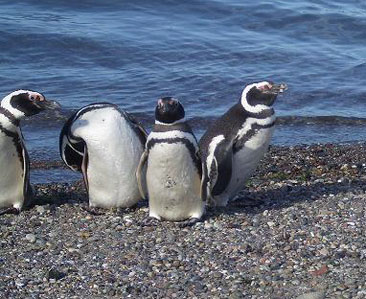Magellanic Penguins See map
Magellanic penguins (Spheniseus magellanicus) spotted by the first Europeans in Magellan's voyage in 1520 were described by the chronicler Antonio Pigafetta as "strangers geese." It is one of the few flightless birds and their wings have become flippers swim.
It lives in huge colonies such as Punta Tombo in Chubut, considered the largest mainland colony, with half a million copies.
 Magellanic penguins.
Magellanic penguins.It is of medium height, between 50 and 60 centimeters, and weighing up to 5 kilograms. It is adorned with a white chest and a white stripe around the head, neck and wings.
Year after year, in August the males arrive at the "penguin". The females arrive in September and begins a period of territorial fights, some very violent, parades with arched necks, short steps, around each other, knocking Peak Dives and mating purposes. In October they dig nests with their feet, if possible under bushes. The pair incubates two eggs (twice as big as a hen) for 40 days.
In November the already born chicks force their parents to go to sea in search of food (fish and squid that they regurgitate prepackaged) and to extreme care to predators, cook and brown gulls mostly.
The penguins nest very close together, causing tension due to lack of space, but also they are better protected by all. In January the chicks are encouraged to move away from the nest.
From December to April plumage move: first the juvenile, then the chicks, preparing to enter the water, and finally the breeders. The winter find them in the warm waters of Brazil.
Viajes por la Patagonia
Related Articles
© Patagonia.com.ar 2025 | Todos los derechos reservados.
